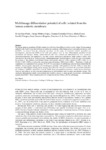Mostrar o rexistro simple do ítem
Multilineage differentiation potential of cells isolated from the human amniotic membrane
| dc.contributor.author | Díaz-Prado, Silvia | |
| dc.contributor.author | Muiños-López, Emma | |
| dc.contributor.author | Hermida Gómez, Tamara | |
| dc.contributor.author | Rendal Vázquez, María Esther | |
| dc.contributor.author | Fuentes Boquete, Isaac Manuel | |
| dc.contributor.author | De-Toro, Javier | |
| dc.contributor.author | Blanco García, Francisco J | |
| dc.date.accessioned | 2015-06-18T08:36:05Z | |
| dc.date.available | 2015-06-18T08:36:05Z | |
| dc.date.issued | 2010-11-01 | |
| dc.identifier.citation | Díaz-Prado S, Muiños-López E, Hermida-Gómez T, Rendal-Vázquez ME, Fuentes-Boquete I, de Toro FJ, et al. Multilineage differentiation potential of cells isolated from the human amniotic membrane. J Cell Biochem. 2010;111(4):846-857. | es_ES |
| dc.identifier.uri | http://hdl.handle.net/2183/14697 | |
| dc.description.abstract | [Abstract] The human amniotic membrane (HAM) contains two cell types from different embryological origins. Human amnion epithelial cells (hAECs) are derived from the embryonic ectoderm, while human amnion mesenchymal stromal cells (hAMSCs) are derived from the embryonic mesoderm. In this study, we localized, isolated, quantified and phenotypically characterized HAM-derived cells and analysed their in vitro differentiation potential towards mesodermal cell lineages. Human amnion-derived cells were isolated and characterized by flow cytometry. Immunohistochemistry and quantitative real-time reverse transcription-polymerase chain reaction studies were performed for the analysis of multipotentiality. Immunophenotypic characterization of both cell types demonstrated the presence of the common, well-defined human mesenchymal stem cell (MSC) markers (CD90, CD44, CD73, CD166, CD105, CD29), as well as the embryonic stem-cell markers SSEA-4 and STRO-1. Phenotypes of both cell populations were maintained from passages P0 to P9. The assessment of multilineage potential demonstrated that the hAMSCs showed greater adipogenic and chondrogenic potential. Both populations had the ability to retain their capacity for differentiation during culture passages from P0 to P4. Our data demonstrate the successful localization and isolation of hAMSCs and hAECs from the HAM. Both cell populations possessed similar immunophenotype. However, they differed in cell yield and multipotential for differentiation into the major mesodermal lineages. Our functional differentiation studies demonstrated that hAMSCs possess a much greater mesodermal differentiation capacity than hAECs. These considerations will be important for use of these cells for cell therapy. | es_ES |
| dc.description.sponsorship | This study was supported by grants: Servizo Galego de Saúde, Xunta de Galicia (PS07/84), Cátedra Bioiberica de la Universidade da Coruña and Instituto de Salud Carlos III CIBER BBN CB06-01-0040. Silvia Diaz-Prado is beneficiary of an Isidro Parga Pondal contract from Xunta de Galicia, A Coruna, Spain. Emma Muíños-López is supported by the Rheumatology Spanish Foundation (SER), Spain. We would like to thank P. Filgueira and M.J. Sánchez for technical assistance. | es_ES |
| dc.description.sponsorship | Instituto de Salud Carlos III; CIBER BBN CB06-01-0040 | |
| dc.description.sponsorship | Xunta de Galicia; PS07/84 | |
| dc.language.iso | eng | es_ES |
| dc.publisher | Wiley | es_ES |
| dc.relation.uri | http://dx.doi.org/10.1002/jcb.22769 | es_ES |
| dc.rights | This is the peer reviewed version of the following article which has been published in final form at Wiley Online Library. This article may be used for non-commercial purposes in accordance with Wiley Terms and Conditions for self-archiving | es_ES |
| dc.subject | Amniotic membrane | es_ES |
| dc.subject | Chondrocytes | es_ES |
| dc.subject | Cartilage | es_ES |
| dc.subject | Cell therapy | es_ES |
| dc.subject | Adipose tissue | es_ES |
| dc.title | Multilineage differentiation potential of cells isolated from the human amniotic membrane | es_ES |
| dc.type | info:eu-repo/semantics/article | es_ES |
| dc.rights.access | info:eu-repo/semantics/openAccess | es_ES |
Ficheiros no ítem
Este ítem aparece na(s) seguinte(s) colección(s)
-
GI-TCMR - Artigos [124]
-
INIBIC-TCMR - Artigos [102]
-
INIBIC- REUMA - Artigos [184]






